The Ultimate Guide To Bullet Journaling For Beginners
Welcome to our detailed guide to Bullet Journaling for beginners that will answer all the questions you might have about this planning system.
This is the perfect place to get started, and I’m excited to be your guide to the beautiful world of Bullet Journaling.
This comprehensive article will explain the basics of what a bullet journal is, why it works so well as an organizational system, plus provide tips and techniques on setting up your own Bullet Journal.
With just some simple planning, tools, and creativity, you’ll soon be enjoying the nearly limitless benefits that come from keeping your very own Bullet Journal. So come on in – let’s get started!

You’re probably here because you’re thinking of starting a Bullet Journal. But what is a Bullet Journal? Would it be a good fit for you? How do you start on such a big project? Probably these and a lot of other questions are floating in your head right now.
I get it – starting something new is always scary and confusing at times. Don’t worry, though, for here I bring to all of you Masha’s Ultimate Guide to Bullet Journaling for beginners! TA-DAAAA!
I started my first Bullet Journal in January 2018 in the hope of using it to find myself and become more productive. But I still remember how confusing and overwhelming my first few months of Bullet Journaling were.
That’s why as soon as I established this blog, I took it upon myself to, first of all, gather together all the information for beginners.
Be sure to check until the end of the post because I do have a special FREE course to help set up your first Bullet Journal.
This post may contain affiliate links. They will be of no extra expense for you, but I receive a small credit. Please see my Disclosure for more details. Thank you for supporting Masha Plans!
What Is A Bullet Journal?
In a few words, the Bullet Journal is a planning system that helps you organize your present and plan your future.
The Bullet Journal system is created around these concepts.
- Bullet Journal Spreads / Collections
Your Bullet Journal is a Lego castle, and the spreads or collections you use in it are the building blocks. The beauty of the system is, of course, that there is a limitless amount of different pages you can use, and you can come up with unique pages suited to your personal needs.
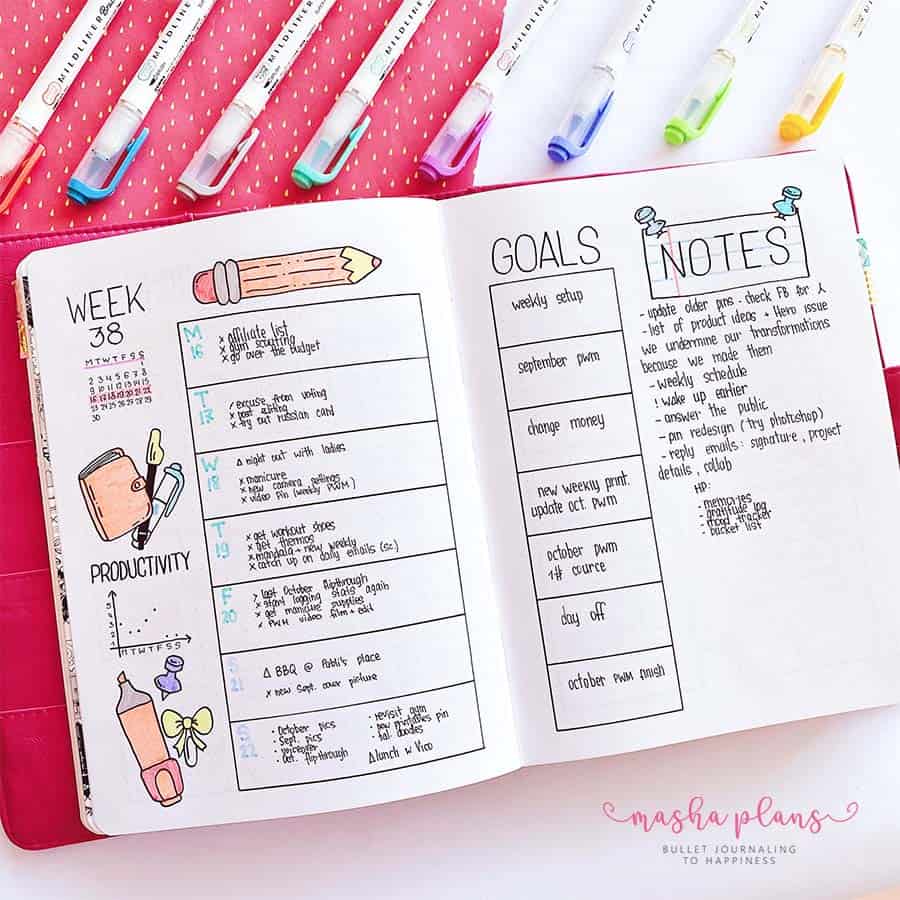
However, there are some core spreads, and we’ll talk later about those.
- Rapid Logging
Rapid logging is the language your journal is written in. It’s pretty simple – all your journal entries are made in short condensed sentences and marked by a special symbol.
- Migration
One of the key ideas of the Bullet Journal is to use it mindfully to make sure you understand why you are doing things and choose to do what’s important.
Migration is a way to review. You migrate your tasks from day to day, from month to month, and then you, of course, migrate your journal to a new notebook. This process allows you to re-evaluate what things are important in your life.
- Reflections
Creative journaling, first and foremost, is about building a better and more meaningful life. Reflections are what help you the most to achieve that.
Every time you sit to plan, reflect on what happened the last day, and think of what you could do better today. This is the way to move forward.
Essentially your Bullet Journal is a mix of different practices and planning methods that brings only the best from each, and it is completely customized to your personal needs.
You can check the overview of the system from this video by Ryder Carroll, who is, of course, the author of this method.
Why Bullet Journal?
It sounds like an awesome system, right? But why is it so great, and how will it differ from all the other planning systems?
Well, having a Bullet journal can be INCREDIBLY impactful, and here is why:
- Using pen and paper will help you to remember things better.
- You’ll be able to concentrate better and find your focus much easier
- You can develop your creativity. Creativity isn’t a secret superpower; just a few chosen ones possess it. It’s a muscle, and you can absolutely train it. Your journal will be a great place to start discovering it in yourself.
- Your journal is your time to spend with yourself, to reflect, and to learn more about your own desires and dreams. It’s a wonderful element of self-care that we all miss in this busy world.
- Once you set your goals, figure out your priorities, and find your focus, you will be achieving more and moving to your dreams much faster.
- Finally, having a huge to-do list in your head that keeps growing can be very taxing on your poor brain. Your Bullet Journal is outside storage for all the data, so your brain can concentrate on completing all the tasks instead.
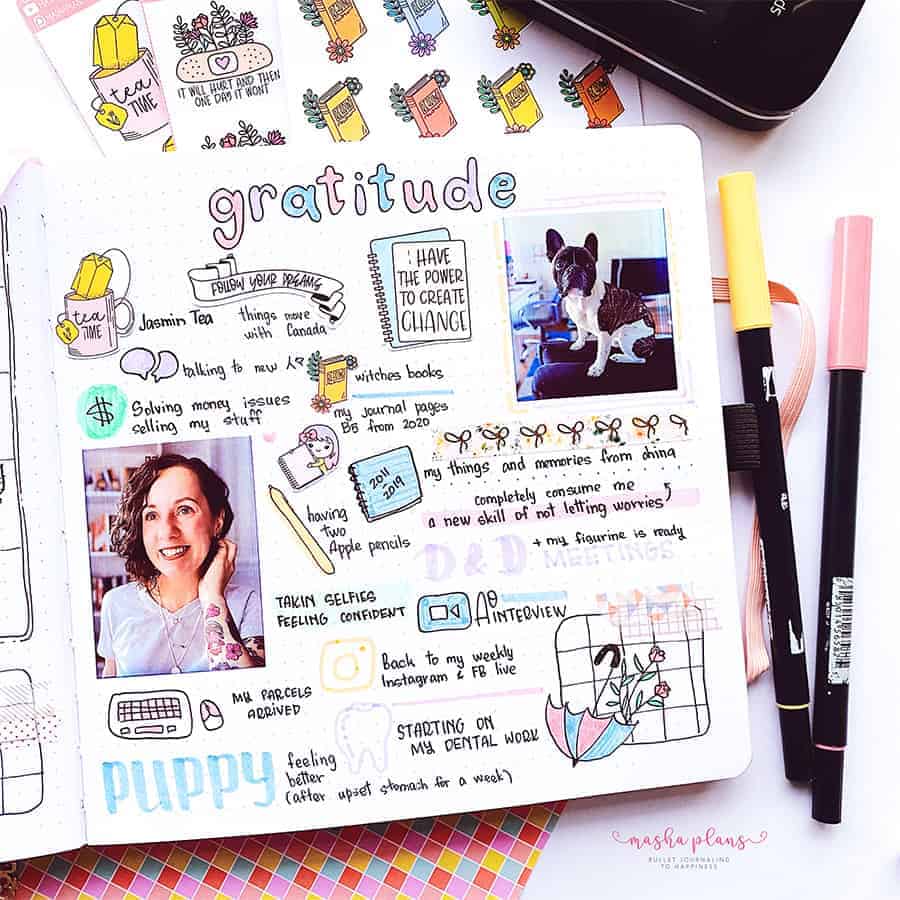
I’d recommend you start a Bullet Journal if:
- You’re a person who’s been having problems with other types of planning and time management systems
- You’re a creative and artistic person and want to bring your personality to your planner
- You want a planning system that you have complete control over and that is 100% created for your needs
- You like the idea of having a planner and a journal in one notebook
The Bullet Journal system might not be for you if:
- You already have a planning system you love, and that works for you.
If you decide to get into Bullet Journaling and commit to it – I guarantee it will do wonders for you.
If, in the beginning, you feel like it might not be such a miracle – it probably just means that you need to optimize and customize it a little bit more.
Thankfully, I’m here for you to help with tons of posts on the blog.
Bullet Journaling For Beginners – Before You Start
Knowing what a Bullet Journal is and that you need one is a good first step. But beware! After that, all the confusion and anxiety settle in! “How do I start? What do I need to BuJo? What mistakes should I avoid?”
The first thing you need to consider is your why. Understanding what’s the purpose of your journal will make it that much easier for you to decide on everything, from what supplies to use to what spreads to create. So before you read all the other tips I have for you, think about your own personal why.
For example, my why was and is to be productive but also to be creative. Yours can be something similar or completely different, according to your needs.
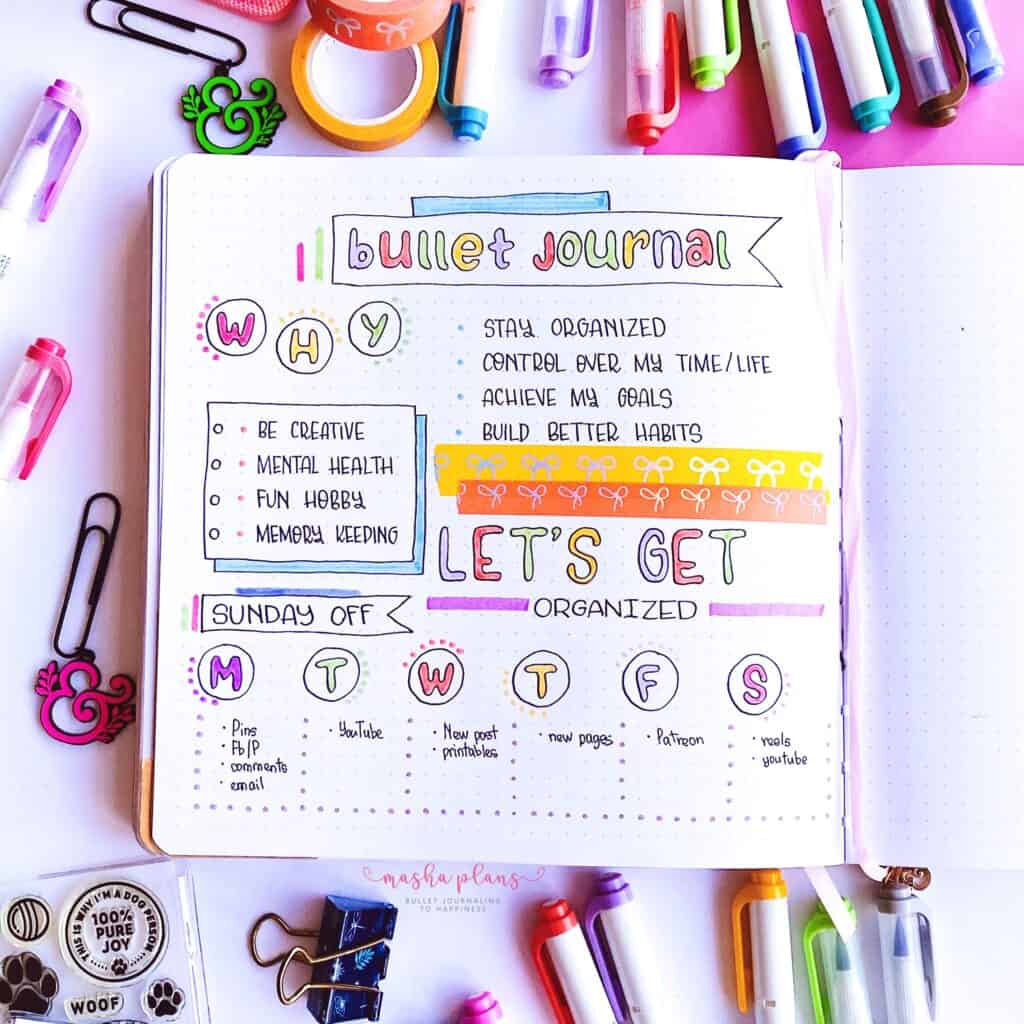
Ok. Decided? Not yet? Take your time. I’ll go have a cup of nice tea.
Are you done? Great! Time to start preparing. Based on all my mistakes and such, here are a few things you should consider before starting:
- Bullet Journal, first and foremost, is an organizational system that helps you to be more productive and mindful. As much as it looks like just an art journal sometimes, keep in mind what the main goal is, and don’t sacrifice anything for just good looks.
- Speaking of good looks, you don’t really need to be artistic to start a Bullet Journal. Your journal is your own, and it can be as messy as needs are. There are many ways you can decorate your journal, even if you’re not artistic, or you can simply go with a stunning minimalist Bullet Journal style.
- There is no one way to Bullet Journal. You can’t do anything wrong because the rules don’t exist. Everyone does whatever works best for them. So don’t feel obligated to use something just because it’s popular in the community.
- Your Bullet Journal is a living notebook; it grows and changes with you. Just like in real life, mistakes happen, but they are what make your journal beautiful and unique. This also means that you should always try new things and new spreads to make sure your journal reflects your current needs.
You’re also often met with misconceptions. Since the method became popular, a lot of different opinions started appearing online, and it became a bit more difficult to figure out what was true and what was not.
Many of these misconceptions might be holding you back from starting and thriving with your Bullet Journal. So definitely check my post on Bullet Journal Misconceptions Debunked.
I could include it here, but then this post would never end.
Bullet Journal Supplies – What Do You Need?
One of the most common questions I get is about stationery. What pens are the best? What journal should I buy? What supplies would you recommend for beginners?
You can start a journal with just a few essential Bullet Journal supplies: a notebook and a pen. That’s it, really! But if we‘re being honest here for a minute, you’d probably want to have a little something extra to add a little spark to your journal, right? I’m here to help you out.
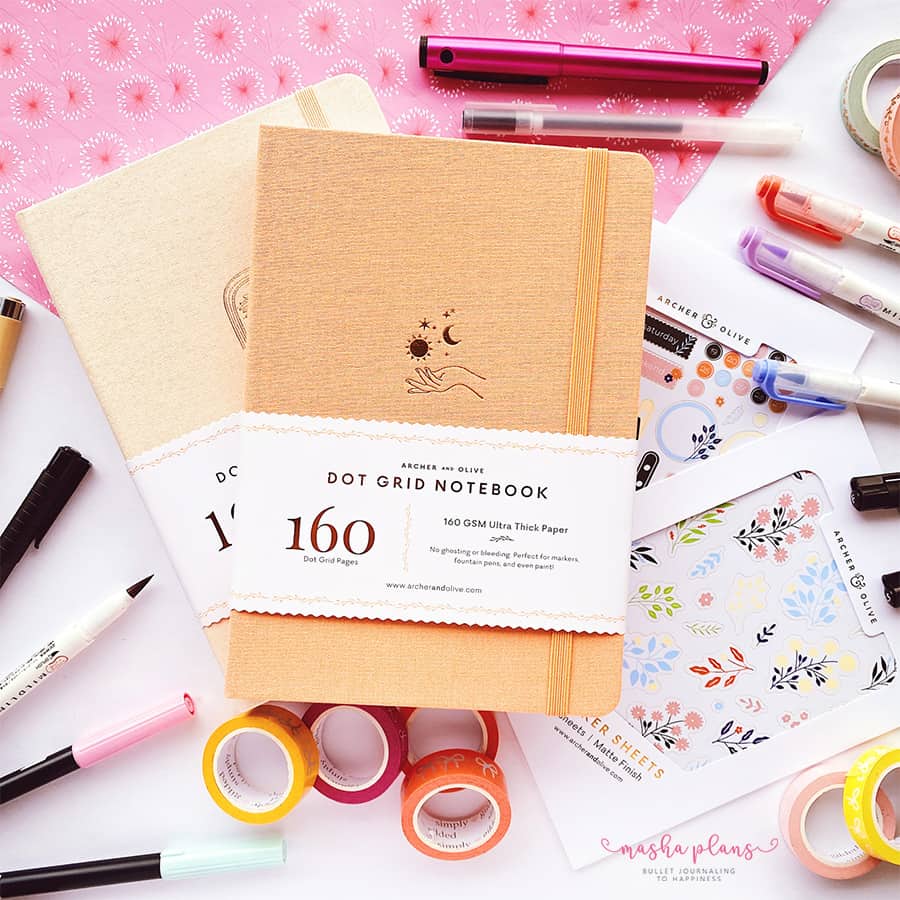
First, let’s get back to your why; this will help you realize what you might need. Are you a busy person and just need a notebook to keep your notes organized? Maybe a notebook and a pen are all you need!
Are you a minimalist and want to have one of those stunning black-and-white journals? Maybe to the usual set you can add a fineliner or two.
Are you planning to use your journal as an art journal and sketchbook? Yes, you’ll need those brush pens!
When it comes to starting a Bullet Journal, I always recommend having a small trial period. Instead of going for the best notebook and buying the most expensive brush pens, get some cheap supplies and have a month or two of tryouts.
First of all, it’ll be a good test for you to see if the Bullet Journal is what you’ve been looking for. Secondly – it’ll give you an understanding of how you want to decorate your journal and what’s your style. That way, you’ll be clear on what supplies you might need to up your game.
If you’re ready to start getting some more supplies, check out my post The Best Bullet Journal Supplies For Any Artistic Level.
First Page Fear – How To Actually Start Writing In Your Bullet Journal
Ok, so let’s say you know what you want from this project, you have all the supplies ready, and your pretty notebook is prepared….
But you never start.
Has this ever happened to you? OMG, guys, it TOTALLY happened to me T_T
My worst fear was the fear of ruining my journal with my horrible designs and my ugly doodles. So I froze and never actually began.
This happened for a long time, even before BuJo, when I wanted to just create a regular journal. I probably lost years of my life when instead of being productive and artistic, I kept on trying to hold it all in my head.
Does that sound familiar? If it does – you’re suffering from first-page fear! Please don’t let it stop you!

First of all – everyone has this fear, even the most experienced Bullet Journalists. So it’s completely normal.
And secondly – your first page will always be the worst! This is pure logic – the more you plan, the better you become, so your very first page will never be as good as your last one.
So don’t let it stop you, and if it’s too much, you can always just skip the first page and come back to it later.
If you want some more practical tips on that topic, check out this post: How To Overcome Bullet Journal First Page Fear.
Bullet Journal First Page Ideas
The other issue I faced when I opened my first ever BuJo was – what should I write on the first page?
A cover page for the whole journal seemed so important and decisive to me that I was confused. To help you avoid this, here are a few ideas:
- Current Year
- Inspirational Quote
- Word Of The Year
- Mandala
The cover page is done; now, let’s get into setting up the journal itself.
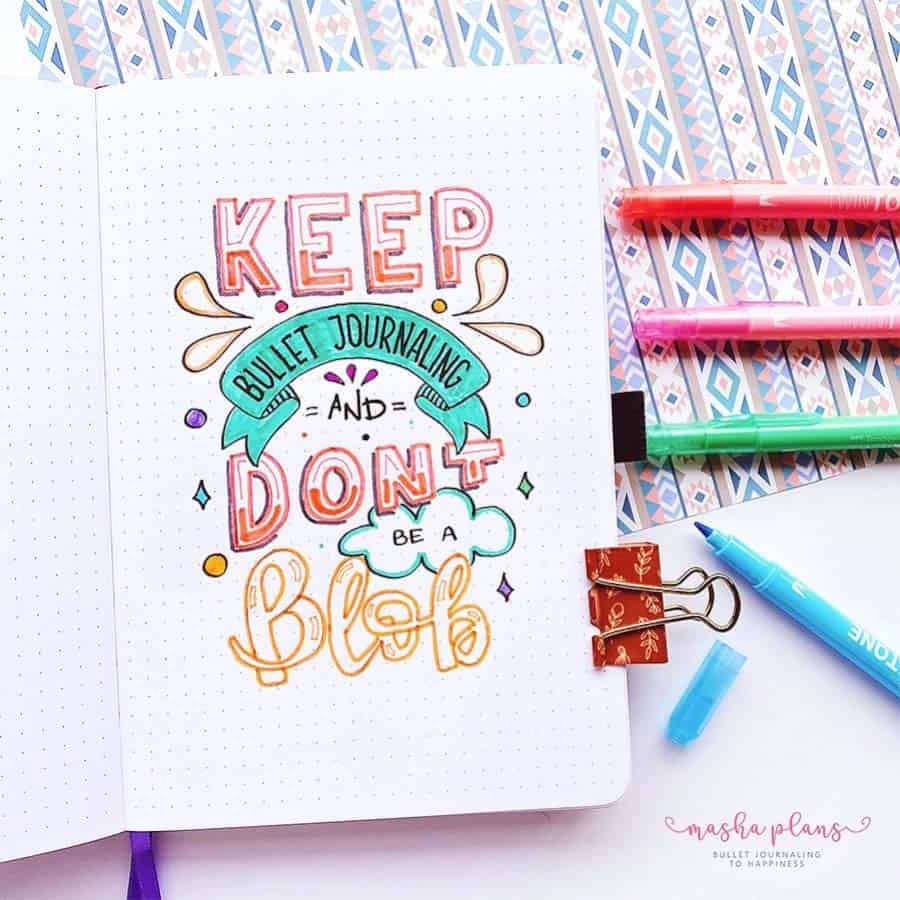
Core Bullet Journal Ideas For Beginners
Setting up your Bullet Journal can be as easy and as time-consuming as you want. Always remember this – you’re the master of your journal, so it can be whatever you need it to be!
The original Bullet Journal system is incredibly simple and easy to use.
Here are 5 which are the core of the system, and as a beginner, that’s where you should start. Of course, your journal is yours, so you just choose the pages you need.
Bullet Journal Key
This spread is a place for you to add signifiers you use for writing down data in your Bullet Journal. As you already know, for writing things in your journal, you use condensed sentences and signifiers so you can input information faster and visually easier understand it.
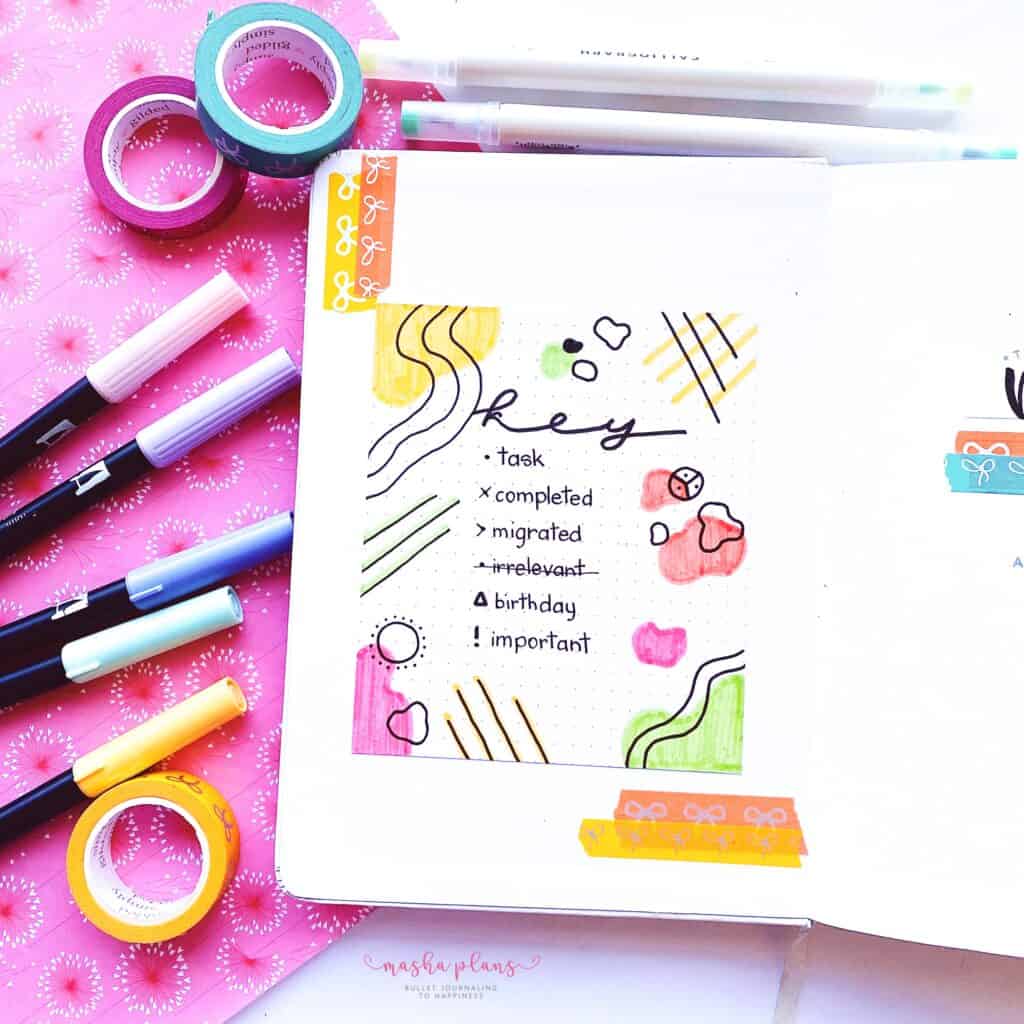
The basic symbols are:
- task
X Completed – once you’ve completed a task, mark it with an X
> Migrated – if you didn’t complete a task, you migrate it to another day
< Scheduled -tasks with specific dates in the future. These can be added to the Future Log.
0 – event
– – note
! – priority
You, of course, are free to use your own symbols and add anything else you feel like you might need.
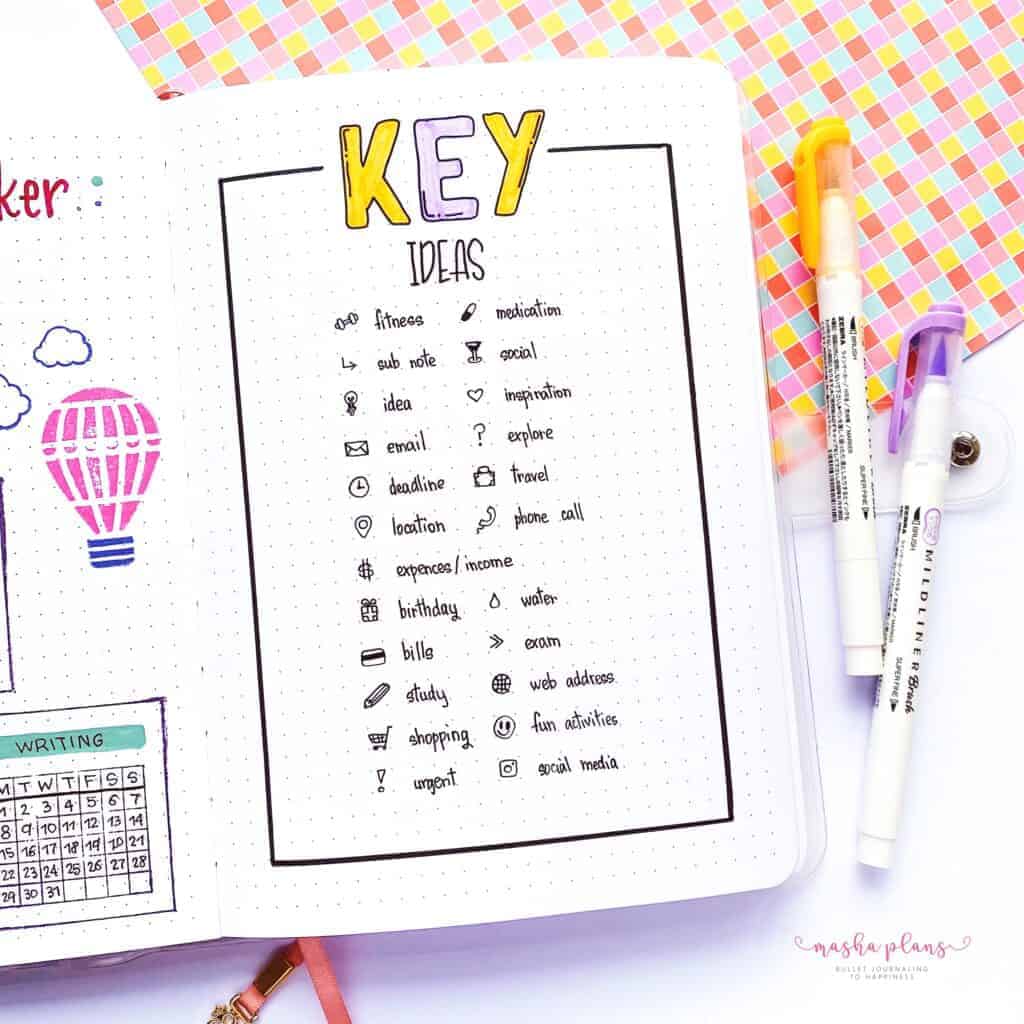
TIP: don’t overdo with your signifiers. They are created so you can input data easier, and the more you have, the more confusing it can get.
TIP 2: try to create your key on the right side of your journal. Especially at the beginning, this will be a spread you’ll reference quite a lot while you’re trying to memorize the symbols. If it’s on the right side of your journal, it makes it easier.
READ MORE: Bullet Journal Key and how to create a perfect one for you
Bullet Journal Index
This is one of the things that make the Bullet Journal method stand out among all the others. You now don’t need to flip through your entire journal, looking for specific information.
Just reference your index page, and you’ll find anything you need in seconds.
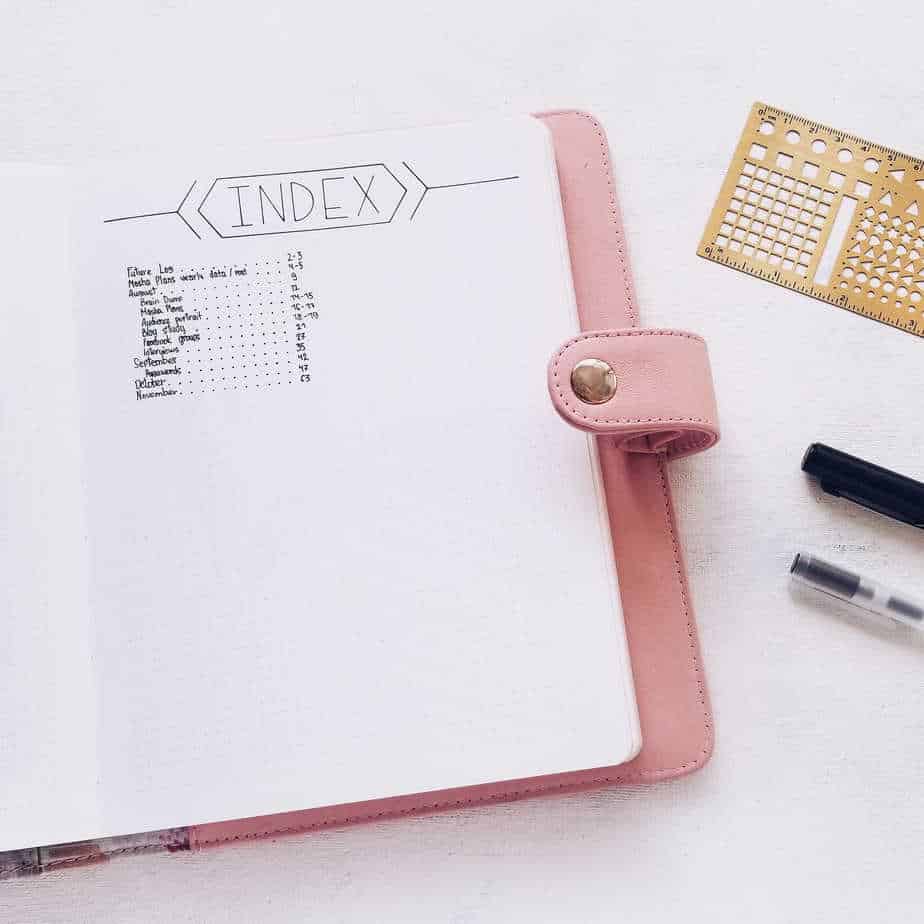
Some journals already have a pre-made index page and numbered pages, but some don’t. If yours doesn’t, you’ll have to create an index page yourself and remember to number your pages as you go.
To make your index work the best for you, you can use different ways to organize it. Your index can be just a simple table of content, or you could make it more elaborate, including color-coding or sorting by categories.
Here are some of the ideas on how you can organize the index in your journal.
- Fill it out numerically. This means that as you go, you write down separately on each page of your journal. This is great because it will create a very detailed index. However, it will definitely take up a lot of space in your journal. Plus, most likely, you won’t need to write down each and every page.
- Fill it out by content. This will definitely save you some space. This means that you combine the same pages from different months in the same line. For example:
Habit trackers – 14, 28, 43
Or you can just write down all the monthly pages together. For example:
December – 60-72 - Divide the content. Another way to fill out the index page is to divide it into two parts. Have one index for your planning pages and a separate one for collections.
READ MORE: Bullet Journal Index – Tips, Tricks, Inspirations
Future Log
Your future log is one of the most important and used pages in your Bullet Journal. This is where you plan your future and organize your year to come.
There are many ways to set up your future log, plus there are a few alternatives you might want to try. Here we will look into the traditional way.
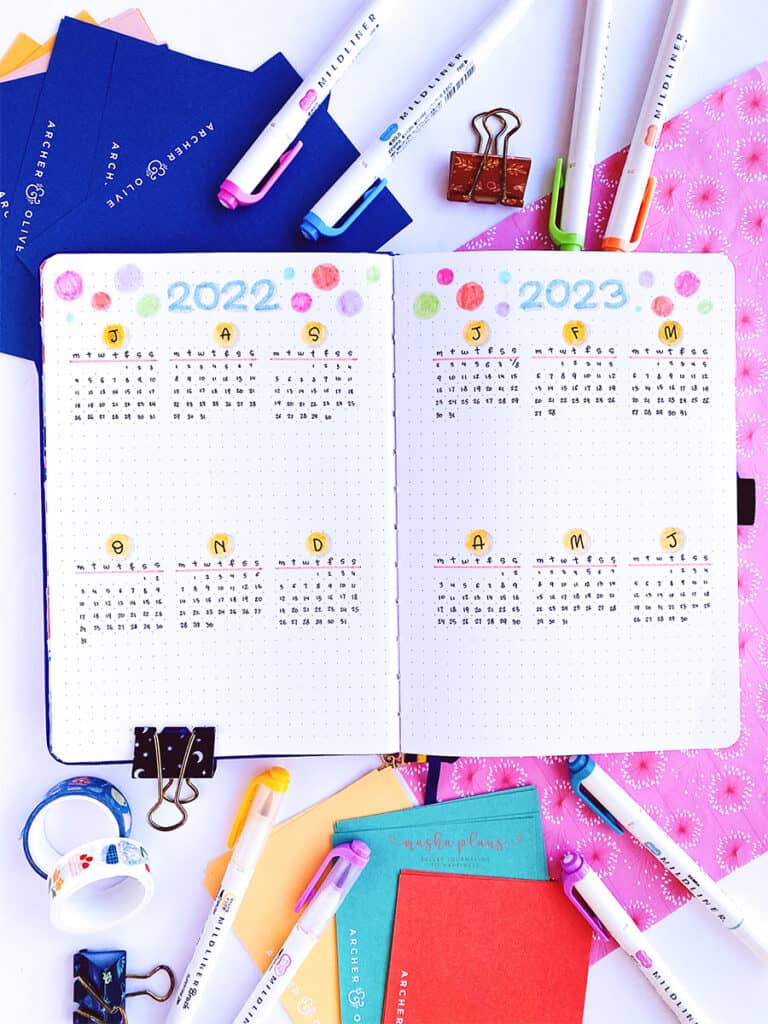
Divide your page into three equal lines. If you use four pages, that should create 12 equal spaces. Add the name of the month and a calendar to each. That’s your year!
You, of course, don’t have to make your future log for a whole year to come, especially if you start your journal in the middle of the year.
You might also need more space if you usually have lots of appointments and stuff to plan, so you always have the option to have only two or even one month per page.
Here are a few ideas on what you can add to your Future Log:
- Annual bills
- Appointments
- Birthdays
- Vacations
- National Holidays
- Deadlines
READ MORE: How To Plan Your Future With Bullet Journal Future Log
Monthly Spread
The Monthly log is where you organize your month; these pages give you a birds-eye view of how your month looks like.
This spread consists of two pages – a monthly calendar on one side and a monthly task list on another.

In your monthly calendar, write all your dates and appointments (consult with the future log we created yesterday!). Make sure you look back at your future log every time you create a monthly log.
Your task list is… well… a list of things to do this month. It’s beneficial to make it at the beginning of every month since it’ll help you remember all the things you want to get done.
There are many interesting and creative ways to set up your monthly log. Personally, I really prefer the calendar look since this is just how I naturally see the month better.
The original Bullet Journal concept offers just to create a column with dates and days of the week. Of course, you can choose whatever way works best for you. Keep on experimenting!
READ MORE: Bullet Journal Monthly Log Ideas And How To Use Them
Weekly Spread / Daily Log
Finally, here are the basics of planning – your daily and/or weekly spreads.
The weekly spread isn’t really in the original Bullet Journal system, but by now, it because an absolute must-have for many of us in the community.
Weekly spreads are a great way to plan for the whole week and see it all at once, which I think is one of the best things about using this format.
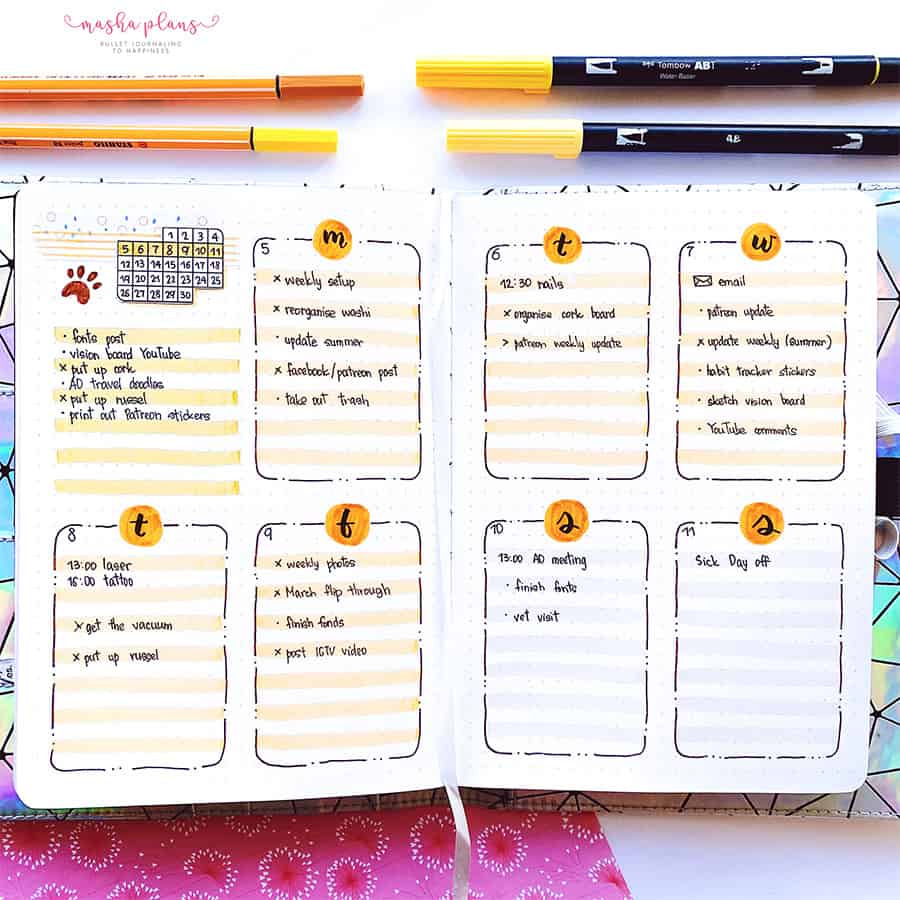
Your weekly is a Lego castle, and you can add or take out any things you want from your setup. Here are a few ideas:
- Weekly habit tracker
- Weekly water tracker
- Notes
- Weekly review
- Meal plan
- Calendar for the month
- Number of the week
- Weekly to-do list
- House chores list
- Plans for next week
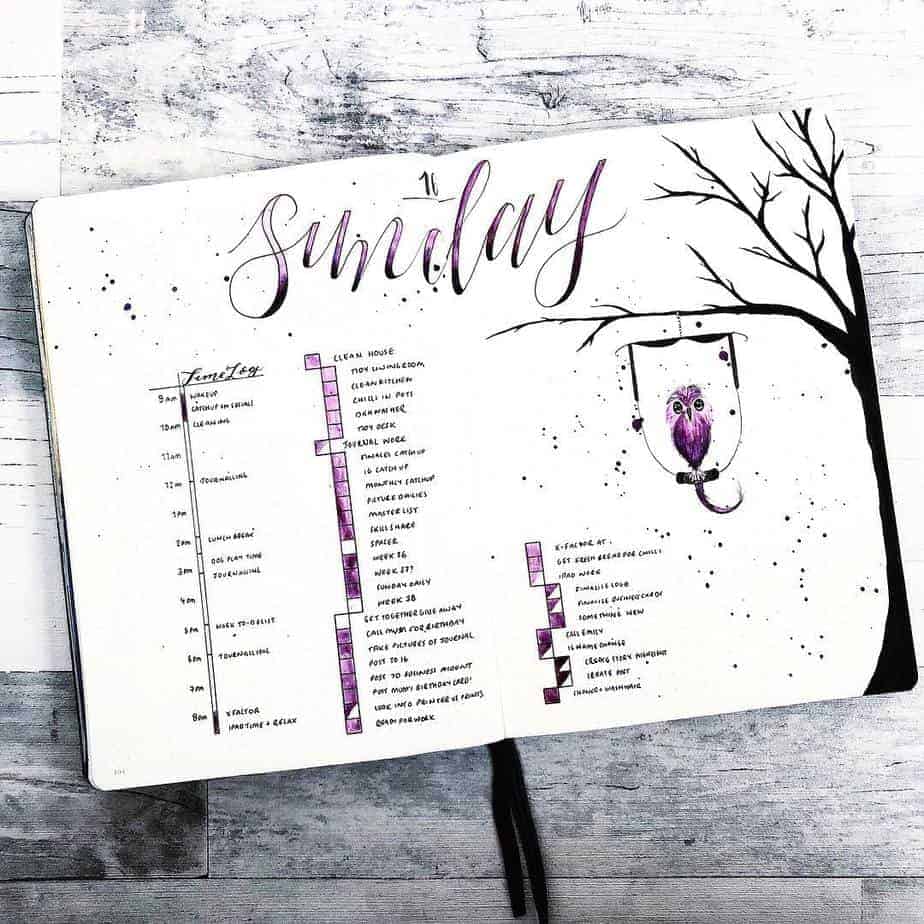
The daily log is where you write your to-do list, your appointments, and deadlines – pretty much everything you need to keep in mind on a specific day.
You can create one page daily or start them as you go and assign as much space for each day as needed.
Daily spreads allow for more detailed daily planning, so if it’s something you might need, definitely give them a chance. Here are some ideas on what you can include in your daily spreads:
- Notes
- Plans for tomorrow
- Daily menu
- Groceries list
- Journaling
- Daily chores
- Weather
- Daily review
- Health goals
- Motivational word of the day
- Time tracker
- Daily challenges (a doodle a day, a line a day, and so on)
You can use just weeklies, just dailies, or maybe even both together. Always experiment and see what works best for you.
READ MORE: Bullet Journal Weekly Spread vs Daily Log
If you want to see a simple setup of all the basic pages, check out my video below.
Bullet Journal Collections
Now that we are done with the basics, time to check out what else Bullet Journal has to offer – collections. Collections are basically spreads created on a specific topic. Collections can be lists, logs, trackers, maps, info dumps, and much more.
Collections are great for exploring new things, staying organized, and generally improving your life. They are also pretty simple to set up – just turn to a new page, add a header with the name of what you want to do on the page, and tadam! It’s ready.
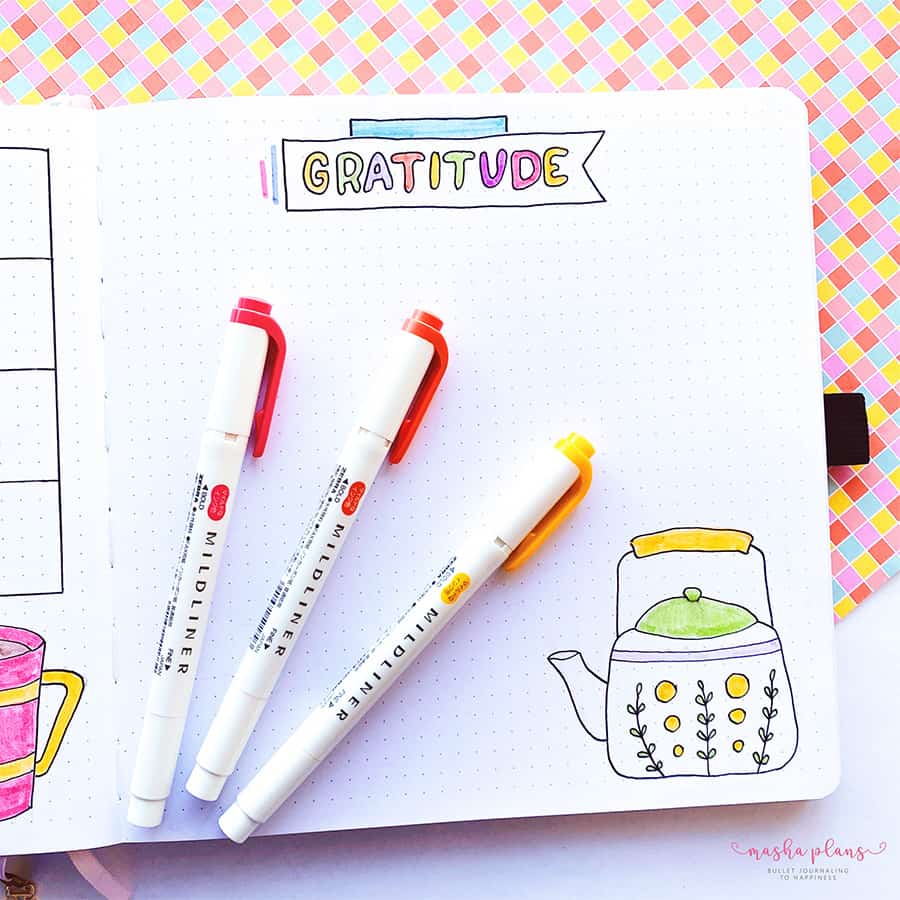
The problem is that there are limitless possibilities out there for the pages to create. And that can be pretty overwhelming.
When faced with the choice of what collections you should include, do this….
First of all – think about the purpose of your Bullet Journal: Do you need to be productive? Or maybe take better care of your health? Maybe you just want to be more mindful? Knowing your “why” is always the first step to creating your own perfect system.
Second – keep experimenting! Try out different pages and see how they work out for you. Don’t try them all at once, but add one page and see how it worked during your monthly review.
But before we get started, here are a few things for you to consider
How To Organize Your Collections
Before we start with the collections, I thought I’d share a few tips.
The biggest problem people usually have is how to organize them, so here are a few tips on handling this issue.
- At the beginning of your journal
That’s the first way I tried, but it came with some difficulties because it definitely added pressure to set up my journal since I thought I had to think of all the collections I wanted to have right away.
- At the end of your journal
This method is great, but it won’t work, of course, if you’re already using the end of your journal for an index page.
I also found that when I ran out of pages in my journal, I still had collections not filled, so I had to migrate them.
You don’t actually have to migrate them, you can keep them in your old journal and keep coming back to them when you need to fill them out, but it seems to be very similar to our third option.
- Use a separate journal
Eventually, I got tired of collections and their big dumb problems and went with this option to teach them who’s boss here. It’s so convenient, honestly! All your collections are separated, and there’s no need to migrate them when you run out of pages.
The only drawback (darn it! It seems we can’t escape you, you evil drawbacks!) of having a separate journal is that you might not use it too often. This totally happened to me.
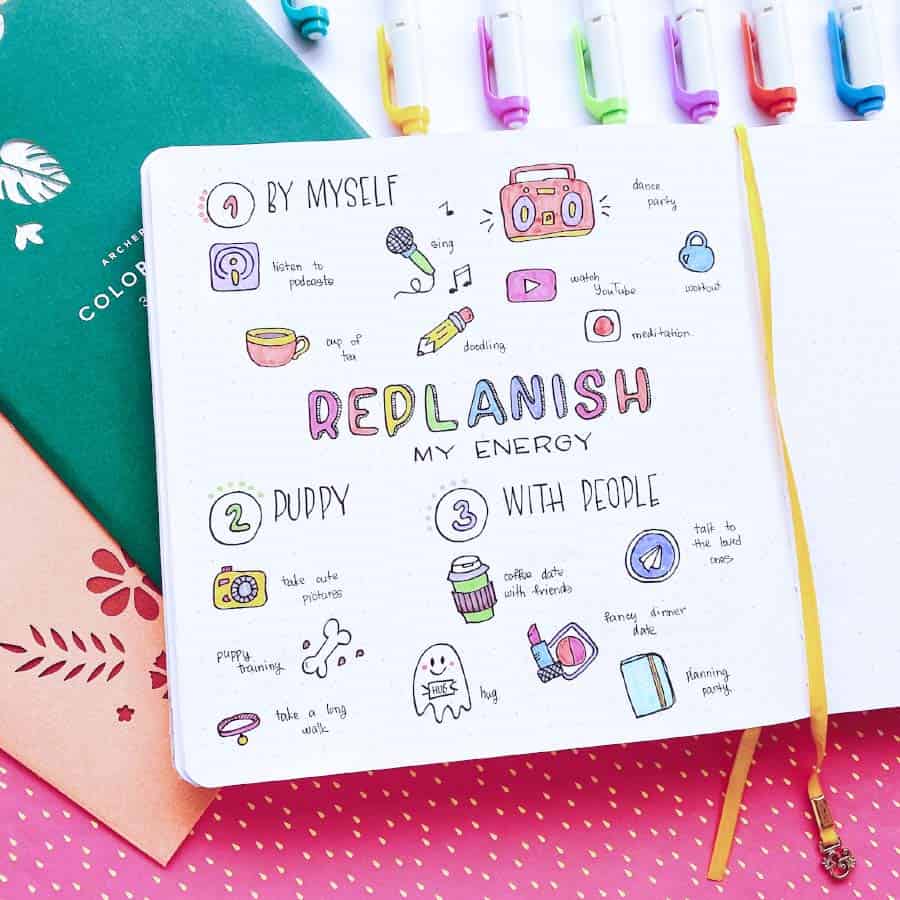
- Use a different type of notebook
If collections and organizing them is something that really bothers you a lot, there is one more option for you – switch to a different kind of notebook.
Disk-bound or ring-bound notebooks will allow you to move around pages, reorganize them, and basically always have the collections exactly where you want them.
Personally, I tried Filofax one as my travel journal, and I love their paper quality.
For some more information, you can check my post How To Organize Collections in Your Bullet Journal
With this out of the way, let’s actually check some collections worth having. Below are some of my favorites and the ones that are more popular in the community for a good reason.
However, always remember that this is your journal made for you. If something doesn’t really resonate with you – don’t do it. Find something that works for you instead.
Annual Goals
Hands down, this is the most impactful spread in my Bullet Journal. I started my BuJo to get myself together, to become more organized, and to start living to my full potential, and none of that would’ve been possible without a goals page.
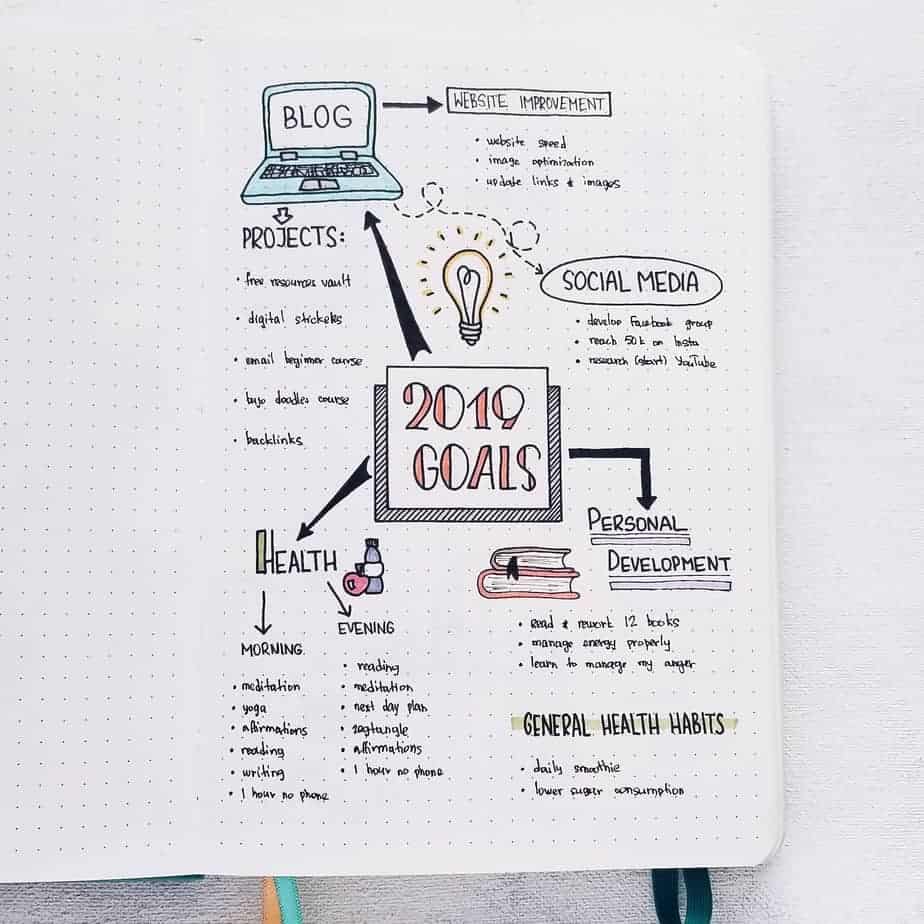
The important thing about annual goals is to keep them flexible. During the year, a lot of things can happen, and sometimes your goals might change.
There is no reason to keep working on something if it isn’t really what you want anymore. Treat your annual goals as a general direction of your life.
READ MORE: How To Set And Crush Goals In Your Bullet Journal
Monthly Review
A monthly review is really a must-have page in your Bullet Journal.
By taking a moment to flip through your last month and think back on how it went, you might be able to get some powerful insights that will, in turn, help you make adjustments to your life and improve it.
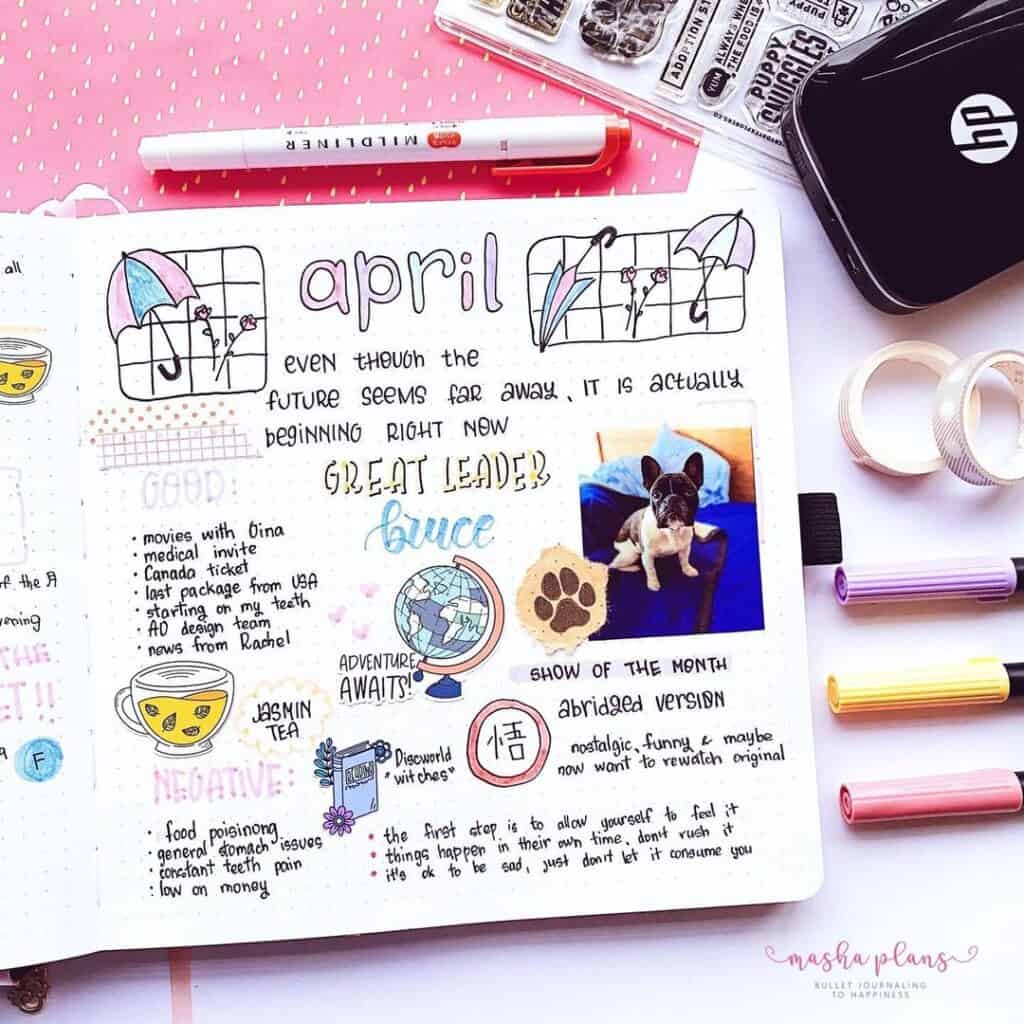
Moreover, why not use your monthly review to audit the pages you had? Take a look at which pages worked, which ones didn’t, and what you might’ve been missing.
This is very useful when you’re building your own planning system.
READ MORE: Why You Need A Monthly Review Page
Gratitude Log
This is a great spread for mental health and generally for a happier life. Making an effort every day to find something to be grateful for is a very powerful practice.

This spread will help you to recognize and be actively grateful for a lot of little things you’ve been blessed with but took for granted.
You’ll be happier and more mindful, and that will definitely reflect in a positive way on your relationships with people around you.
READ MORE: Bullet Journal Gratitude Log For Happiness In Your Life
Habit Tracker
For me, it’s a definite must-have page for each monthly setup.
Habit tracker helps you to develop better habits and get rid of unnecessary ones.
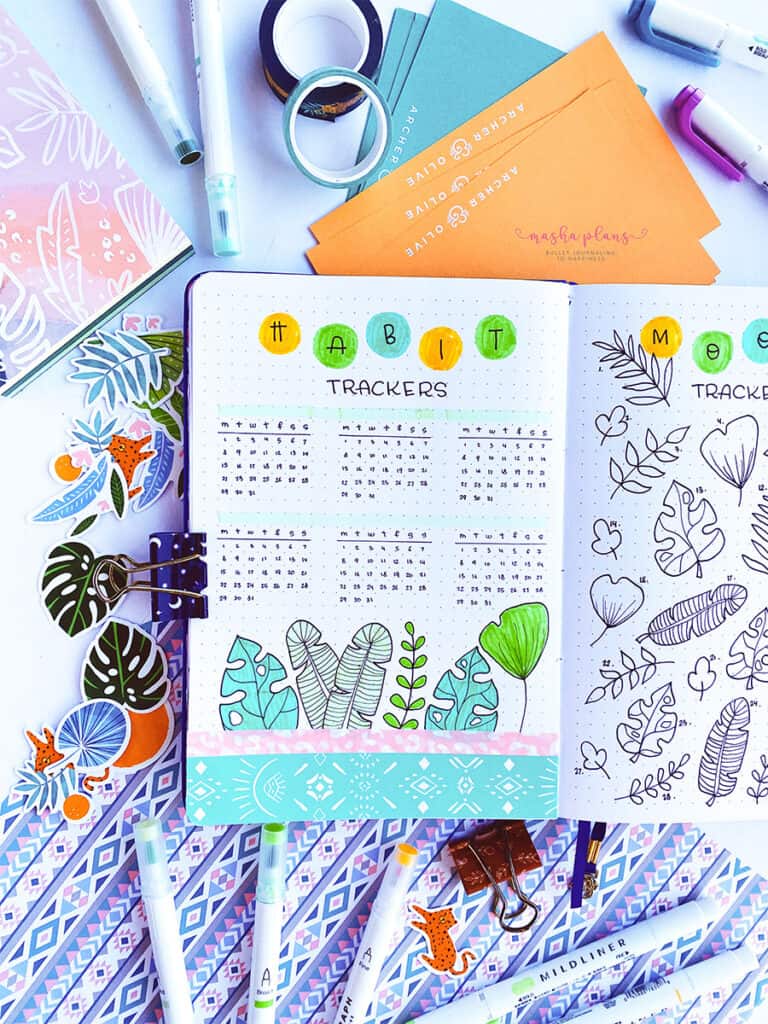
It works pretty easily. You set a few habits you want to track for a month, and every evening, you sit down and mark which habits you completed during the day.
After weeks or months, you’ll clearly see your patterns, so you’ll know why some things are difficult and what you need to do to achieve what you set to achieve.
READ MORE: The Ultimate Guide To Habit Trackers
Mood Tracker
Whether you’re fighting mental illness or just looking for a way to bring more happiness to your days, a mood tracker can be the tool for you.
Once you set to track your moods, you’ll be able to see interesting patterns and learn what actually influences your bad moods.
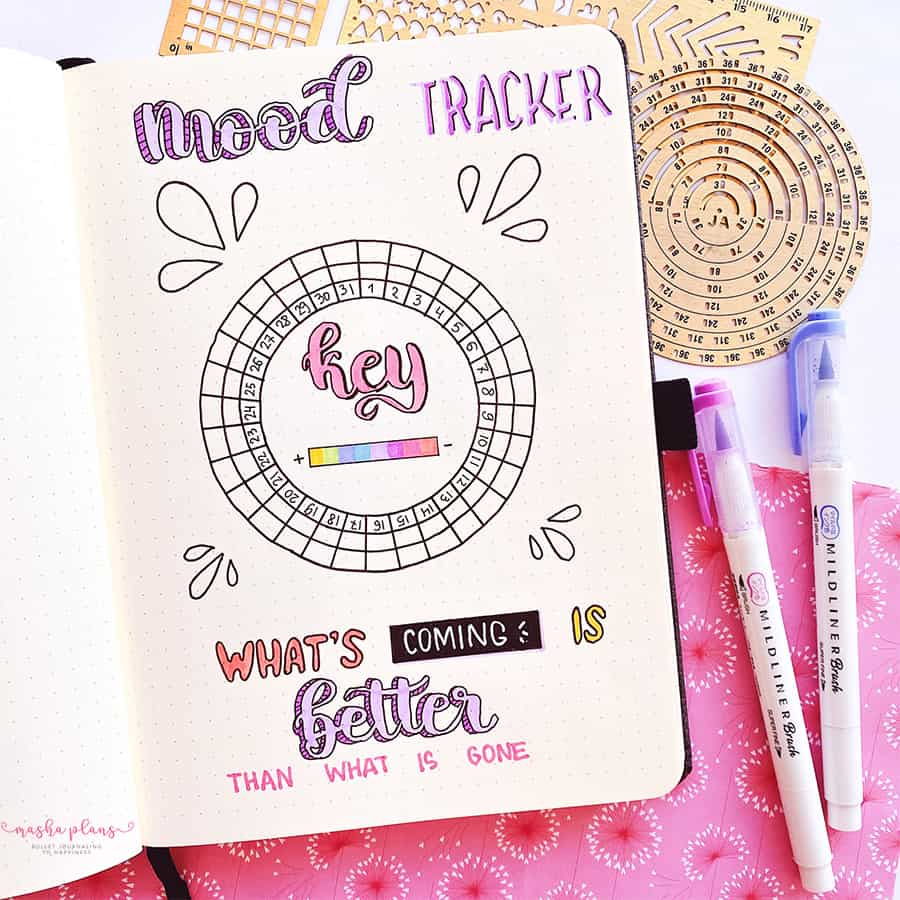
Once you know the “why”, changing your attitude or fighting the illness will be that much easier!
For more about mood trackers, check my post: 35+ Fun and Creative Bullet Journal Mood Trackers And How To Use Them.
If you want to get some more ideas, check out my resources hub Bullet Journal Page Ideas where you can find 300+ different ideas and inspirations for pretty much any area of your life.
Find Your Bullet Journal Style
Looking at my pages full of doodles and color or at the work of some other creators like, it’s easy to get intimidated and feel like Bullet Journaling is absolutely not something you could do.
But you would be wrong. We all choose our own style that fits our needs and personalities.
If you want to just use black and white – be it! If you want to add colors and drawings – that’s your choice.
Always remember that it’s your journal and your rules; nobody can tell you what to do there.
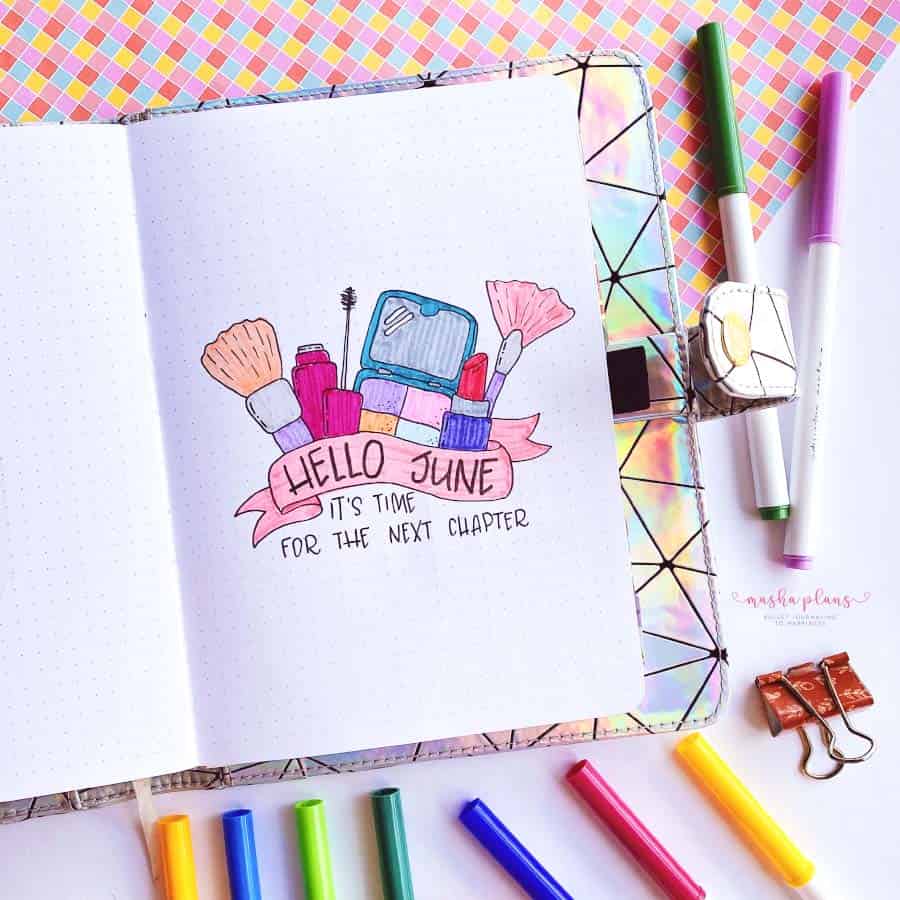
Your style might also vary as you go and get more skills, like drawing or lettering. Or when you discover some new stationery, like my style changed when I discovered washi tape.
The key here is to keep experimenting and trying new things until you find something you like and feel comfortable with.
To get you going, here are a few types of styles you might want to try out.
Minimalist Bullet Journal
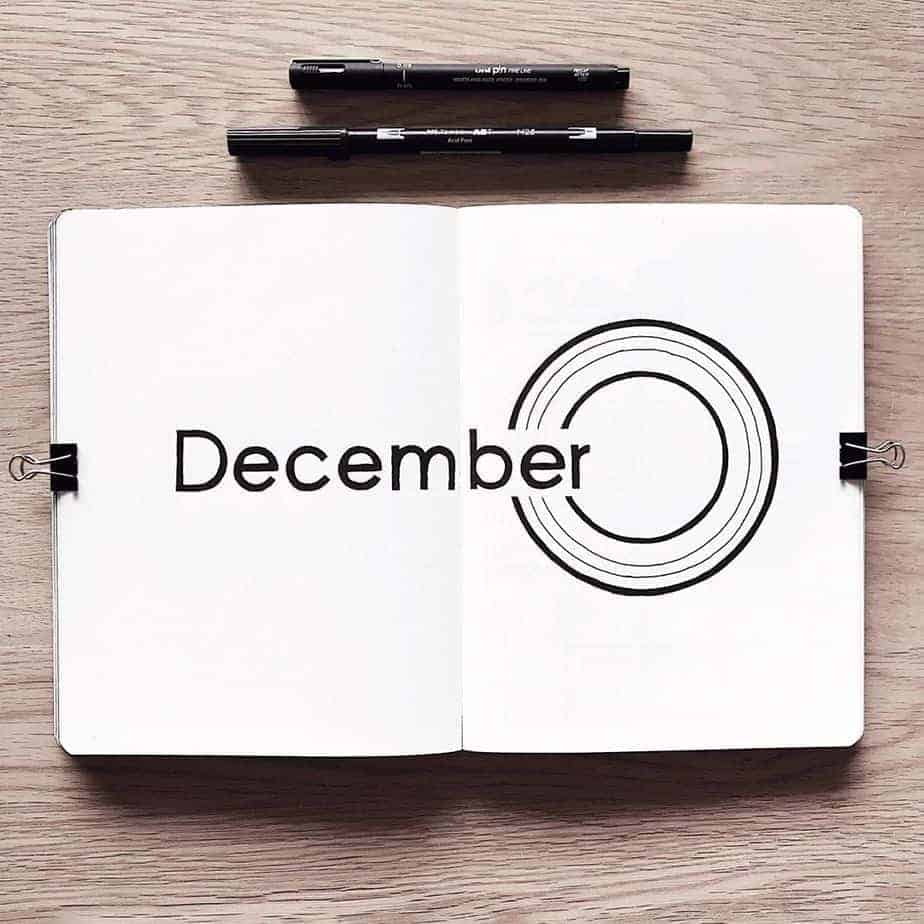
This word means something different for everybody, but when it comes to Bullet Journaling, it usually means simple spreads in mostly monochrome colors with basic designs or none of them whatsoever.
Minimalist Bullet Journal spreads are usually pretty easy to set up; they are extremely functional and have a lot of white space. At the same time, they look absolutely stunning!
Minimalist spreads are great for beginners because they don’t require any special skills and also don’t distract you from the main goal. They are also fantastic for busy people because they take the minimum amount of time to set up. And a minimum amount of stationery as well.
Artistic Bullet Journal
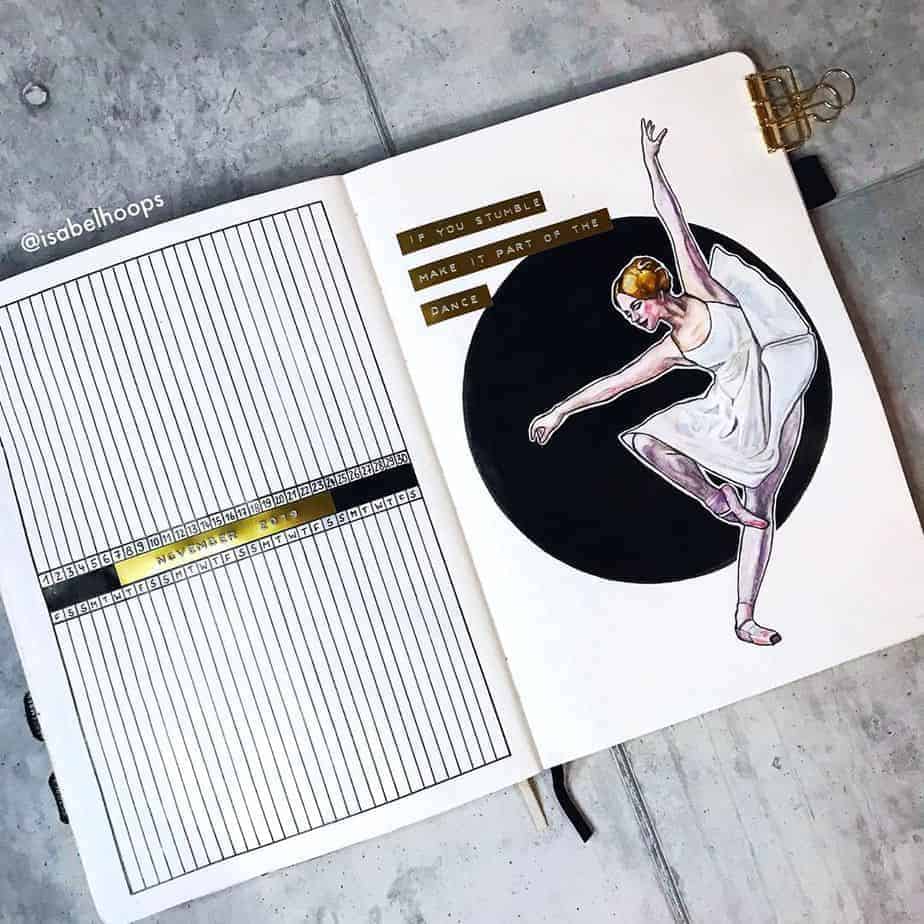
These are those crazy pretty journals with drawings and paintings. Yes, these pages take more time to set up, but drawing is also a kind of therapy, and being creative in your Bullet Journal is just another benefit the system offers you!
If you feel like bringing your creative juices to your Bullet Journal pages, definitely give a look at this style.
Doodly Bullet Journal
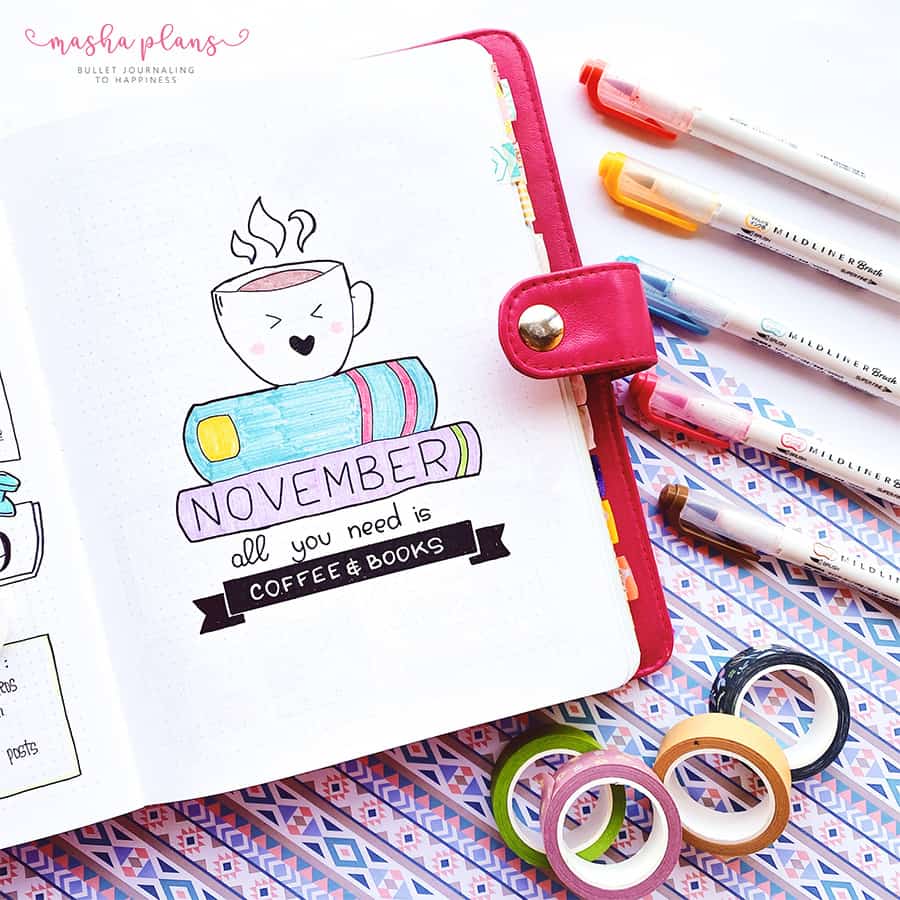
This style is for somebody who is creative (and we all are!) and wants to bring it to their journal but maybe isn’t really in the artsy stage yet.
I think this is a perfect description of my own style!
Learning to doodle is pretty easy, especially if you have good teachers. I have quite a few doodle-related posts on my blog to give you a start, so be sure to visit my post hub How To Doodle.
Scrapbooky Bullet Journal

This type implies the use of different media, such as photos, journal cutouts, stickers, post-it notes, and washi tapes. This style is incredibly beautiful!
Whatever style you end up having, always remember that this is what works for you. There is a lot of criticism going around the Bullet Journal community, but don’t you ever listen to it?
Your planner – your rules!
How To Decorate Your Bullet Journal Pages
One objection I hear a lot is “I’m afraid to start Bullet Journal because I’m not artistic and can’t create beautiful pages”.
Well, let’s talk about that!
First of all, Bullet Journal isn’t about pretty pages! (well, ok, unless you really want it to be and you are like, crazy talented, in which case, share your art so we can all be j̶e̶a̶l̶o̶u̶s̶ inspired by you in the comments!). Where was I? Oh right. You can get all the perks of the Bullet Journal method with just structured notes.
Second – there are ways to decorate your journal, even if you don’t know how to draw. Seriously! Check out a few ideas here:
- Stencils
- Stamps
- Washi Tapes
- Stickers
- Collages
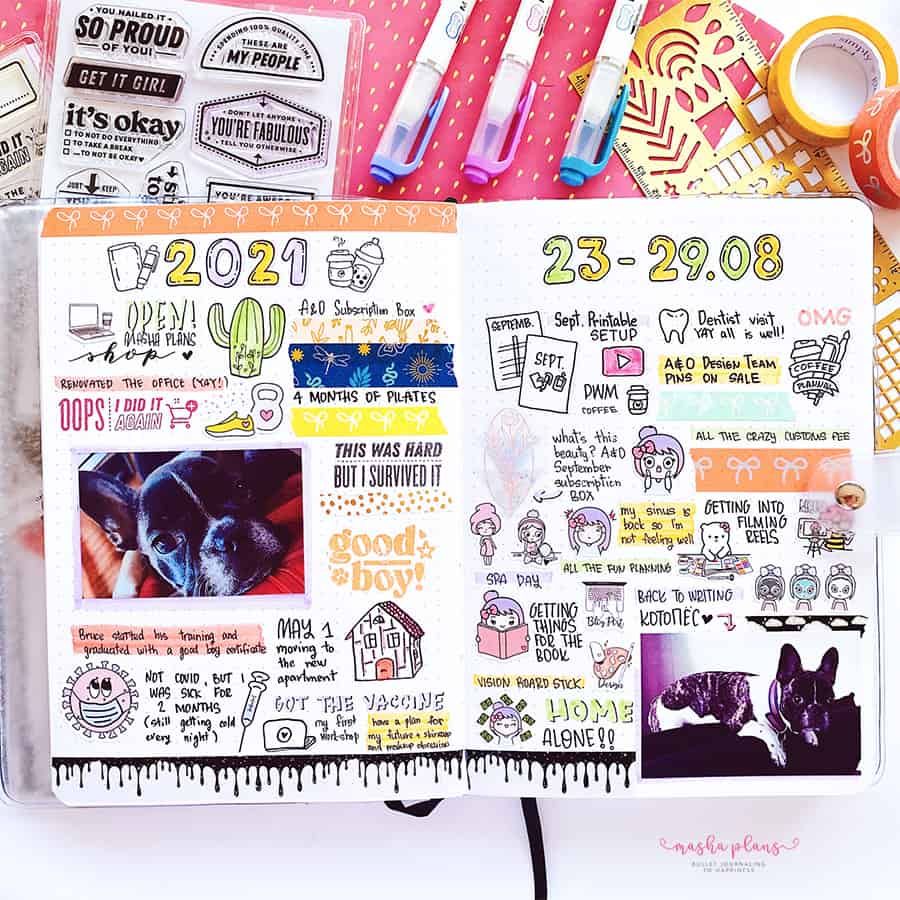
READ MORE:
- 9 Bullet Journal Decoration Ideas Even If You’re Not Creative
- 9 Simple Ways To Decorate Your Bullet Journal
Just remember two extremely important things:
- Don’t compare your journal to others. It’s your journal, and you have your own path. Get your inspiration from others, of course, but only compare yourself to yourself some time ago!
- In time and with practice, you will get so much better! How do I know that? When I started my Bullet Journal, I had no idea whatsoever about how to create pretty pages; I didn’t know how to draw, match colors or compose a well-structured page. But I didn’t let that hold me back. Now, In less than a year, more than 50K people follow me on Instagram and enjoy my spreads, which is ABSOLUTELY CRAZY. If I can do it, anyone can!
The secret for me is continuous learning. Ever since I decided to start Bullet Journaling, I have kept looking for places to learn something new to develop my creative skills.
The first thing that helped me was Skillshare – an online learning platform FULL of different classes to bring your journal to the next level. Doodling, lettering, watercolor – you name it, and they have it.
As a member of Planning Mashers, you can get 2 weeks of Skillshare Premium FREE if you join via this link. The two months were enough to teach me all I needed to finally start believing in me and creating the pages I liked; plus, I fell in love with this platform and have actually stayed a member ever since.
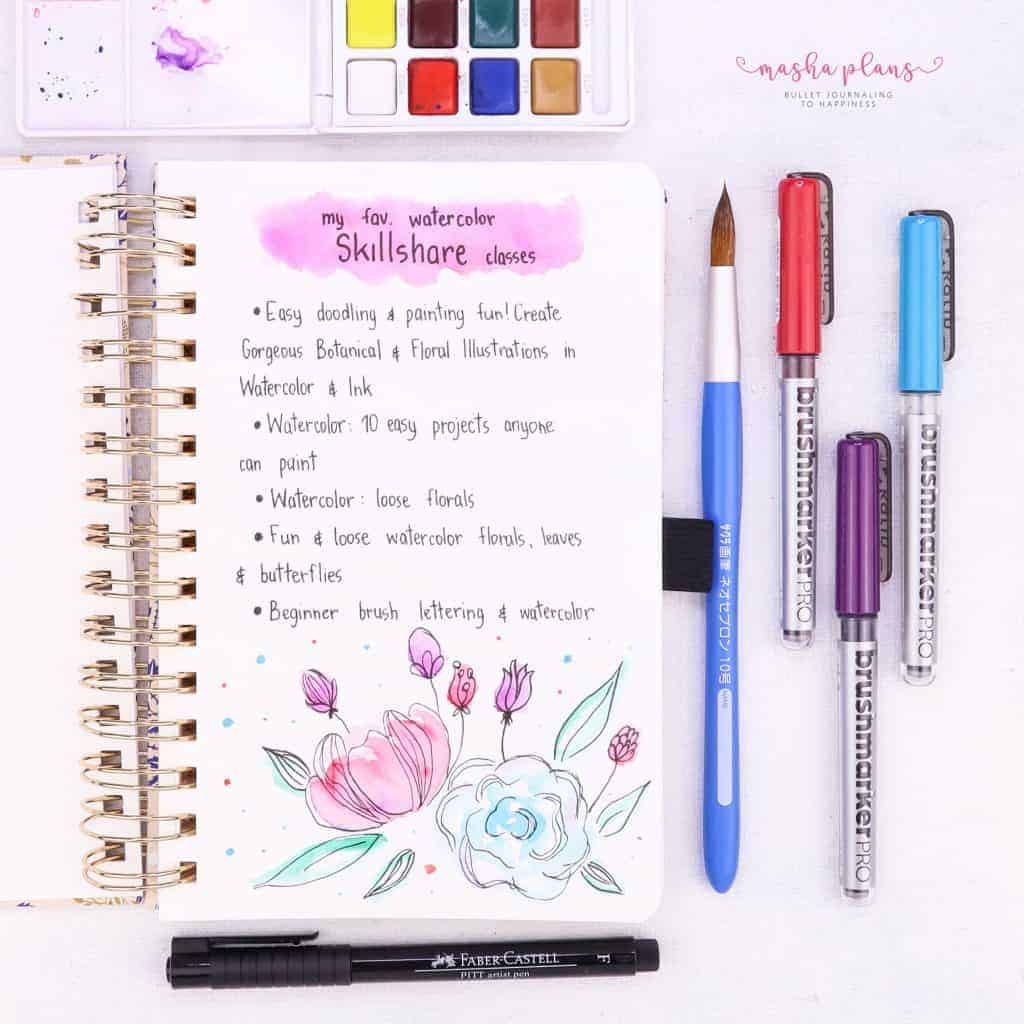
You can also check out Creative Planning Academy – my own learning hub where you can see courses and ebooks to help you with your Bullet Journaling and creativity.
Meanwhile, start your creative journey with these posts:
- Free Resources To Learn How To Doodle
- Free Resources To Rock Your Creativity
- Foxsy Review: Learn Doodling, Lettering, Watercolor, and more!
How To Deal With Bullet Journal Mistakes
When you’re creating your Bullet Journal spreads, it’s important to remember that you are human, and mistakes happen. It’s in our nature; that’s how we learn! Even the most experienced Bullet Journalists suffer from occasional mistakes, and it’s ok.
Don’t let the fear of mistakes hold you back or frustration ruins your Bullet Journal experience.
I make mistakes all the time – I measure my tables wrong, I misspell things (every time I get corrected in the comments, my ego suffers quite a beating T____T), I don’t align things properly – you name it, it happened, and it still happens to me!
Yet, with all that, I’m also quite a perfectionist, so unperfect pages used to drive me crazy.
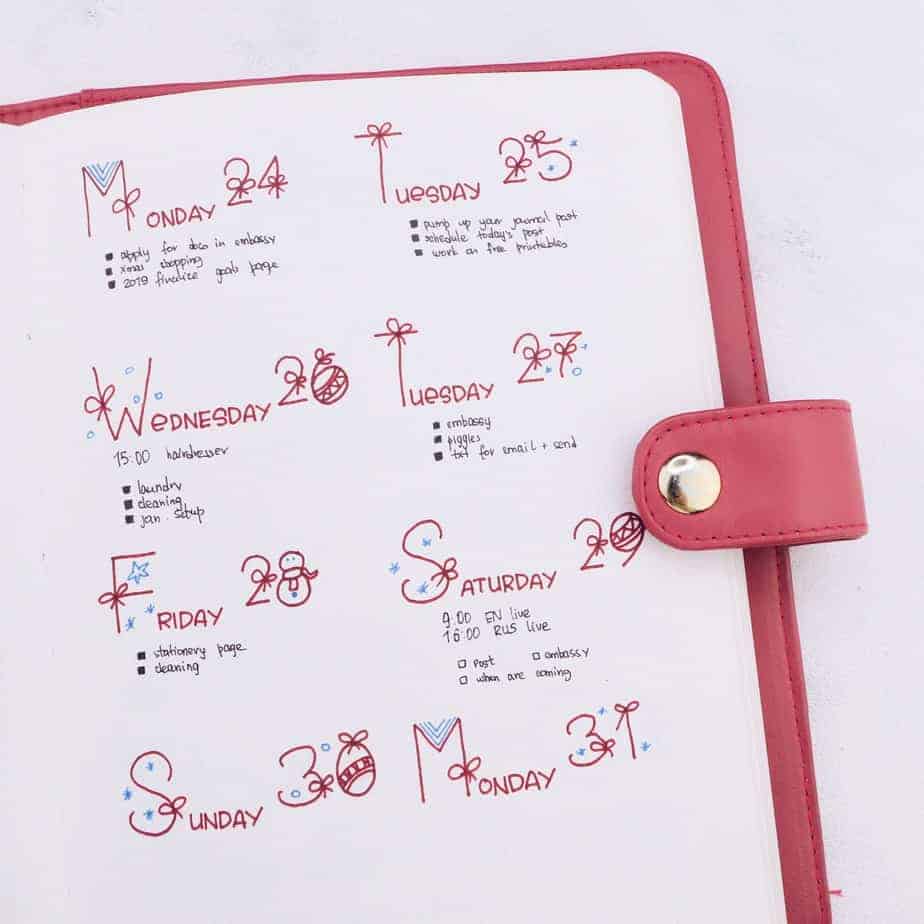
I still needed to have a structure, and I needed my Bullet Journal, so instead of freaking out and abandoning everything, running to my bedroom and hiding under my blankie away from this hating world (like I often felt like doing), I came up with ways to deal with this and to fix my mistakes. So much so that some of my pages actually got better because I made a mistake and had to fix it creatively.
Want to know my secret? I wrote a huge blog post where I talk about techniques you can use to overcome that little perfectionist with you and 11 Creative Ways To Deal With Bullet Journal Mistakes.
How To Start Your Journal In The Middle Of The Year
You either finished your journal in the middle of the year, or you just learned about the Bullet Journal system and want to start right away without waiting for January 1st.
In a way, it does kind of contradict our mind – all things have to start from Monday, the first of the month, or even the first day of a new year.
However, you have to fight this impulse. Why wait for that proverbial Monday if you can start using your Bullet Journal and improving your life right away?
And honestly, it’s not that different from setting up your journal for January 1st.
I usually set up my journal in June each year (except for 2020, it seems like this journal will last me until November). So feel free to check my post on How To Start A Bullet Journal In The Middle of The Year to see how I tackled it in my BuJo.
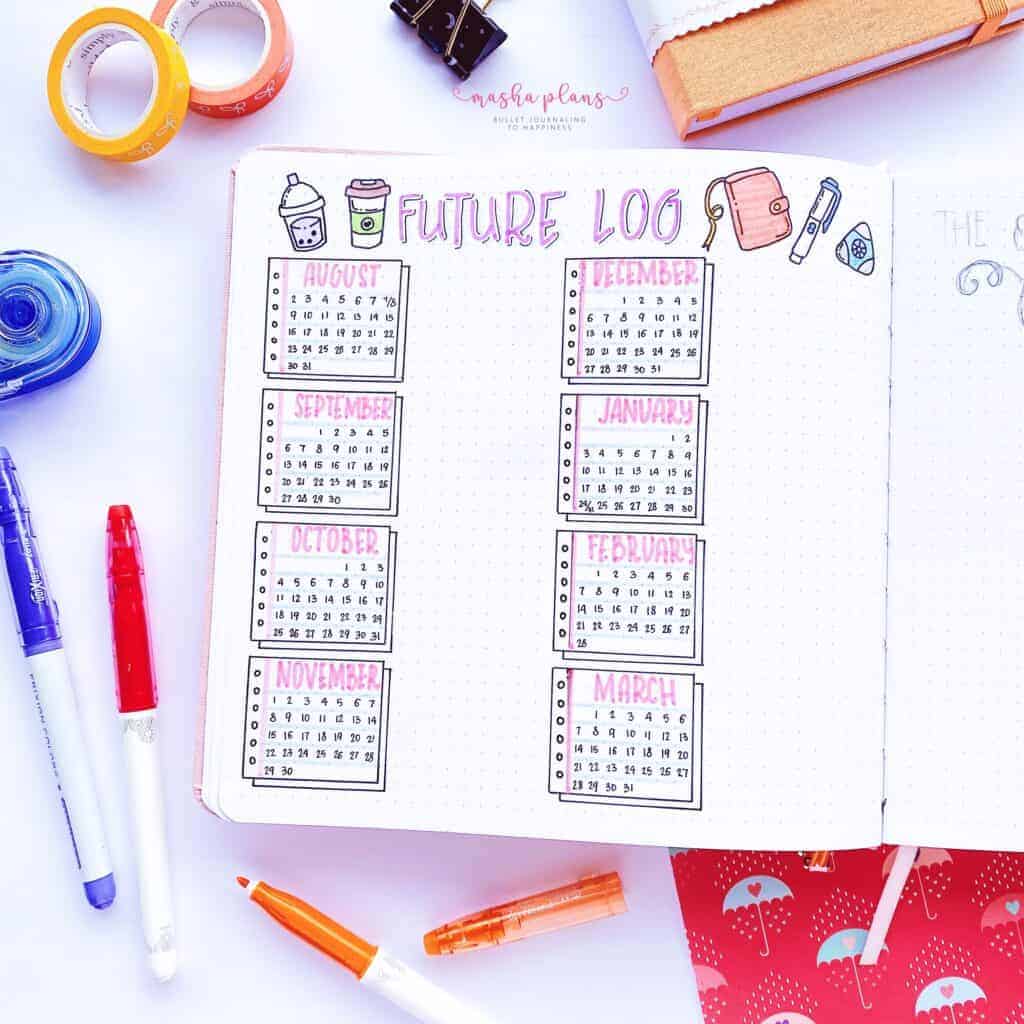
Generally, the entire process is the same; the only difference is your future log. In my setup, I created a future log that lasted from June 2019 to June 2020 – the entire year from the month I started.
But since your journal might not last that long, you can set up your future log for just half a year, and then if it surprises you and lasts for longer, you can add another future log somewhere in the middle of your journal.
Remember that you can add the pages anywhere you want; with an index, you’ll be able to easily find your new future log. Or just create a bookmark to make it always easily accessible.
I know we always feel like we need to do something special for the new year. Well, just add those special yearly pages before you start setting up for January.
Create a spread like “word of the year” and it will beautifully divide your last year from the new beautiful year approaching.
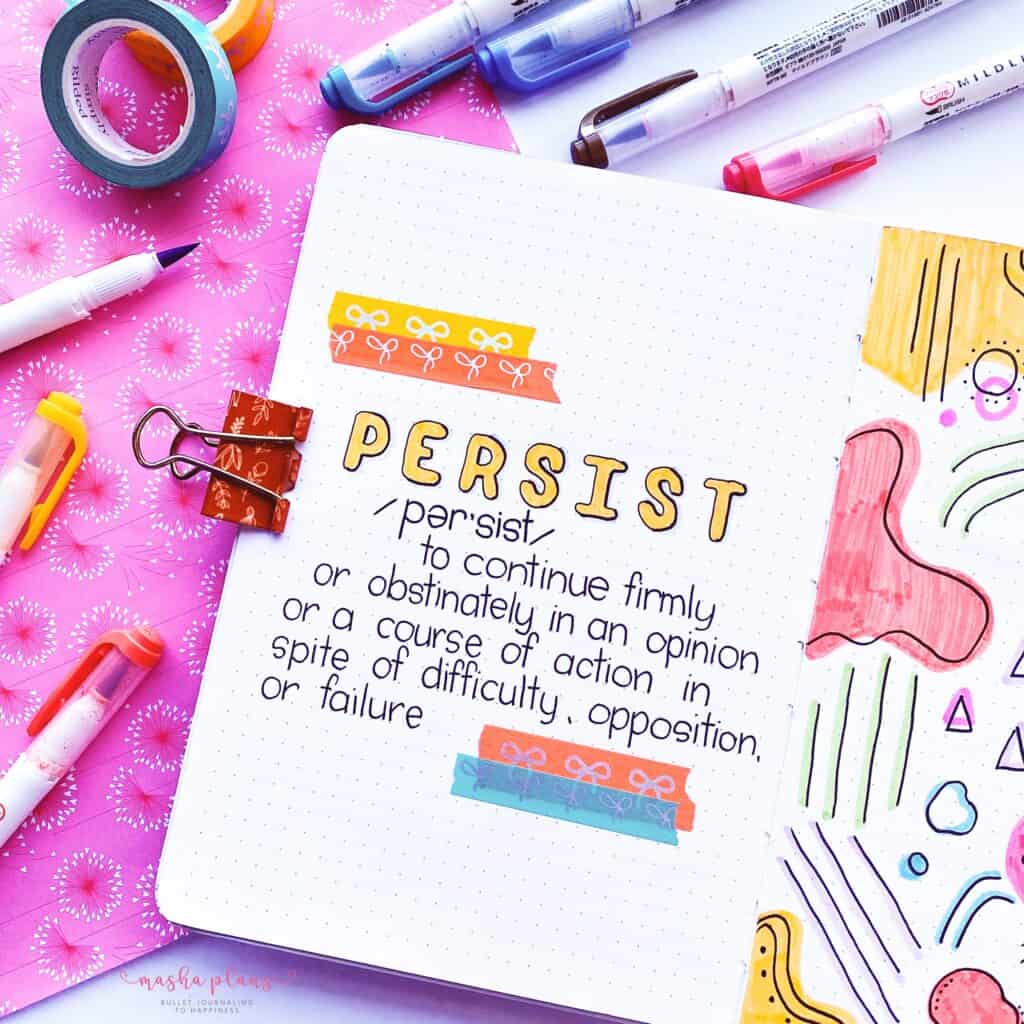
Digital Bullet Journal
Another trend that started up lately is digital Bullet Journaling. Even though it seems to contradict the original concept, it’s still just another way to plan, and it has its own advantages.
I tried digital Bullet Journaling myself, and I must say it is pretty fun.
The main benefit I saw was how much easier it was – you can correct all mistakes in just one tap, and you can reuse your headers or any other designs.

It, of course, is also very convenient if you travel and move around a lot; with a digital Bullet Journal, all you need is just one iPad.
If you want to go digital, here are the supplies I’d recommend:
You can create everything by yourself from the start, or you can get some help and buy an already pre-made Bullet Journal. I got this one from Etsy, and it’s basically a digital version of a dot grid notebook.
I do is usually create my layouts in Procreate because it allows me to be more creative with lettering, doodling, and so many things.
After it’s all done, I just save it as a PNG file and export it to my planner in Goodnotes.
I must say I didn’t go back to digital Bullet Journaling. As fun as it was – for me, nothing can replace paper, and I’m just enjoying using all my pens and notebooks too much.
But it might be a good option for you!
Bullet Journal Tips For Beginners
Before we get into the FAQ section, let me share with you some of my best tips.
I’ve been Bullet Journaling since 2018, and when I started, I learned by doing rather than by reading guides like this one.
So I did make pretty much every mistake in the book. I’m kind of a pro when it comes to giving tips to beginners.
- Don’t Overdo It
Don’t try out every page at the same time. It will just overwhelm you, and you’ll stop using your journal altogether. Take it one step at a time.
- Experiment
Yes, don’t overdo it, but do keep on trying new things. New spreads, new layouts. Bullet Journal is a customizable planning system, so you need to keep trying to customize it to your needs by trying new things and figuring out which ones fit you and which ones don’t.
- Give It Time
I know “ain’t nobody got time” these days, but you have to give yourself some to make your Bullet Journal work. Your pages won’t look perfect the first time. You won’t find your ideal setup and style in just one day.
- No Crazy Shopping
The important thing to understand is that when you start Bullet Journaling, you don’t know your style, you don’t know what you’ll like or what stationery you will need. So start small and expand your collection as you go and understand what things fit you and your Bullet Journal needs.
- Don’t compare
With Instagram and Pinterest full of amazing Bullet Journal pages, it’s easy to start comparing yourself to others and end up feeling pretty sad. Believe me; I’ve been there. This will only hold you back, though! Look at these pictures as inspirations and just fun ideas to try in your journal, but never compare yourself to these.
Remember that we all start off at square one; what you see on social media is usually the result of years of practice and mastery.
Just check out this throwback to when I started Bullet Journaling; it looked nothing like what I create now.
The most important tip, though, is to have fun with it. Remember that your Bullet Journal is a helpful tool, not a chore or a source of stress.
But that’s not it! I also asked experienced and well-known Bullet Journalists to give their best tips for beginners. Here is the link – 9 Ridiculously Useful Tips For Bullet Journal Beginners.
I think we covered it all, I bet you don’t have any excuses left, and you’re ready and motivated to dive into Bullet Journaling. Time for the final part of this post – Q&A
Free Course “Bullet Journaling For Beginners”
Looking for some more help with setting up your Bullet Journal? Join our FREE course on how to start a Bullet Journal.
I’ll be walking you through the process of setting up your Bullet Journal page by page. Give me just a few days, and you’ll have your Bullet Journal all ready!
That’s about it for now. Do you have any questions? Please leave them in the comments section below; I’d love to know what are your Bullet Journal struggles and help you join our wonderful community.
Hope this post was interesting if you find it so, please share! If you enjoy my content and want to show your appreciation, please consider supporting me with a cup of coffee.
And remember: Keep Bullet Journaling, and Don’t be a Blob!












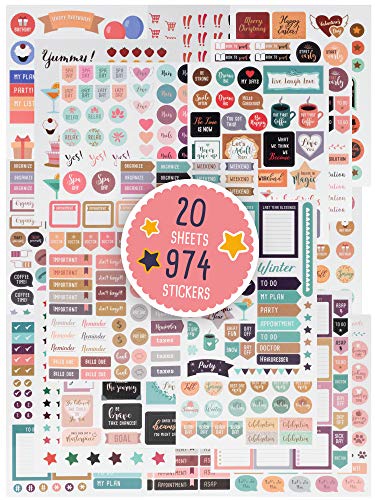



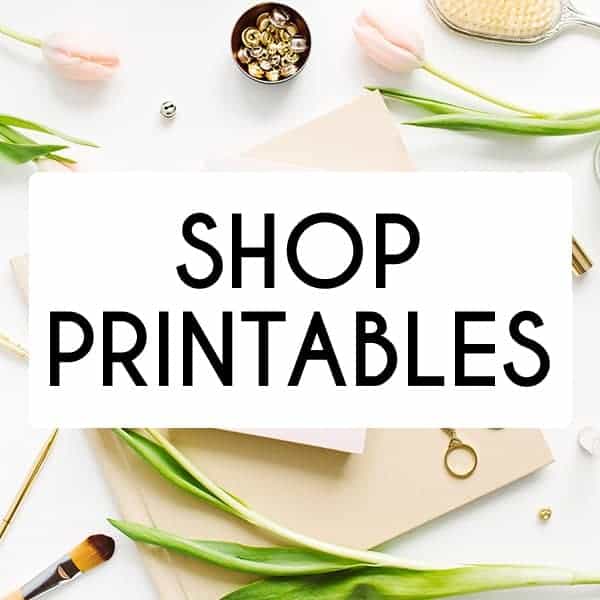
Thank you for all these ideas. I have been stuck on ideas of what to do in my journal and this has helped me a lot.
Thanks again.
Xxxx
So happy to hear it was helpful!
Thankyou for All the guides and information. It is something I am new to but do a lot of journalling. I am trying to do a Bible Journal and find I have trouble with doing the weekly updates and logs as I get too many ideas and have journals and scrapbooks that I love but not a lot of information like a index etc. I love the free side of doodling as lists I find and organising seem to get worse so bullet journalling might be worth a try ! I have too many projects! Do you buy the grid dot notebook? I have a grid notetbook for some of my doodling time. There also so much stuff on art that I find my brain gets over loaded too! Is there a way you deal with this?
Thanks for your time 😀
Hey Debbyann!
Thank you for your comment, I’m glad you found the post useful. I feel like I was in the same place as you are right now, and for me, the solution was Bullet Journal. It helped to organize my time and set my priorities straight, so now I have a chance to do all the things I want to do.
What helped me when I had way too many things I wanted to do, I just wrote it all down and kind of kept something that gave me a spark. I want to do a lot of things but I found that when I put it on paper and reread it I kind of know what are the things I want to do especially badly.
The second thing I did is to compare what I want to do with my goals. There are some things I had to put on a waiting list because I know there is a limited amount of time and now I needed to choose the fun things that would also help with my goals.
I see that you have a lot of artistic things you want to do, I think you can just incorporate them into Bullet Journaling! If you just add a bit of structure to your creative work, such as index and planning pages and whatever else you need for organization, I’m sure it’d work amazingly! And yes, I use a dot grid notebook for my BuJo =)
When you get overwhelmed a great technique is to also just do a brand dump and unload all the tasks and all the information. This really helped to see everything in perspective and to plan everything better.
Establishing a habit to do something daily, such as daily logs and updates really takes some effort. I found that what really helped me to establish this habit is knowing my why. Like with my Bullet Journal I knew I needed it to bring my life into order, so I always felt motivated and kept reminding myself to use it daily.
I hope I understood your questions correctly and my answer was useful. Let me know if there is anything I can help you with!